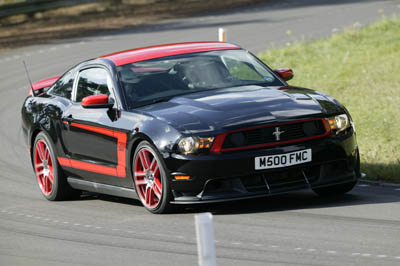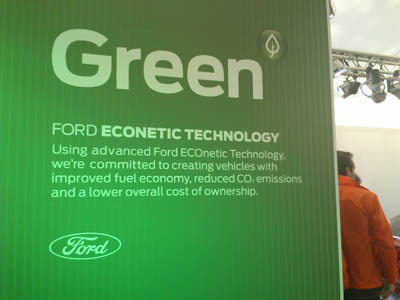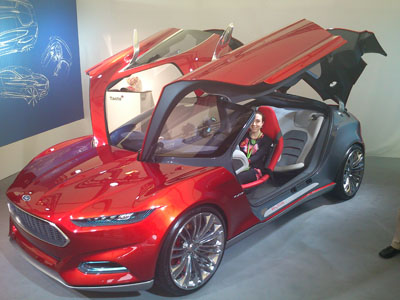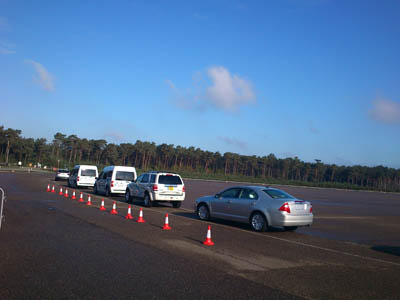The Ford Evos Concept car, recently unveiled at the 2011 Frankfurt Motor Show. Ernesto Rupar, design manager Exterior Design at Ford's Cologne facility, explained about the concept car's features and Ford will embrace them in future vehicles
This week I had the opportunity to visit Ford Motor Group’s Lommel Proving Ground in northern Belgium, one of the world’s leading car test centres and the site where Ford develops and tests out its newest vehicles and technologies, with its engineers pushing prototype Ford cars to their limit before they go into production.
Putting the consumer right at the heart of its future strategy, Ford was eager to showcase how it is incorporating the four pillars of Quality, Green, Safe and Smart into its future models, putting consumers’ needs right at the heart of its engineering process.
Lommel is not normally accessible to the media, but this week Ford opened up the test centre to European journalists so it could showcase some of the electric and hybrid technologies it is pioneering, as well as communicating how it is integrating IT and smart technologies, such as seats that monitor your heart rate, into its future car models.
Ford has also pioneered the world’s first inflatable rear seat belt that deploys in 40 milliseconds. So we got to experience the seat belt in action. Very nifty. As well as this I had the chance to use the Park Assist function on the Ford Focus, a very useful new technology for those like myself who find parallel parking a bit of a nightmare, especially in the city centre.
Secret location of Lommel for vehicle testing
Set on 322 hectares, and surrounded by lush, green woodland to banish out spy photographers, Lommel has 80km of test tracks, ranging from dirt roads to a high-speed oval. Lommel boasts 17 test tracks so its engineers can carry out high-speed handling manoeuvres. The facility employs 70 engineers, 300 supporting staff and it gets between 35 and 100 visiting engineers from other Ford facilities each day.
On entering the grounds you pass by prototype vehicles that are camouflaged in order to protect them from being recognised. The Lommel facility itself opened in 1965. So good are its testing roads for cars that other automobile companies sometimes rent out its durability tracks and corrosion facilities to test out their own vehicles.
It’s a 24/7 operation at Lommel, where engineers work in shifts to constantly test out prototypes under harsh conditions, driving Ford vehicles at top speed over every type of road surface. Annual testing mileage is 6,000,000km.
Ford Mustang in action at Lommel last week

New Ford Mustang in action at Lommel Proving Ground last Thursday – there are just two available in Europe right now
We also got to experience a gorgeous, almost sinister looking, red and black, new Ford Mustang. Some of us were even lucky enough to be a front-seat passenger in the Mustang during some hot laps at Lommel. There are only two of such cars in Europe right now.
Round-the-clock vehicle testing at Lommel
According to Valere Swinnen, director of the Ford Testing Facility at Lommel, the 24/7 operation ensures that Ford converts its programmes in the shortest possible time.
He said that Ford listens closely to how its customers measure the quality of Ford’s vehicles, with the company translating customer research into engineering processes.
Swinnen said that quality must be what you can hear, see and rely on.
“We test cars under harsh conditions. We want the car to feel the same after ten years of use.”
Ford’s electrification plans to 2020

Peter Schmitz, technical leader for powertrain electrification in Ford of Europe’s Research & Advanced Engineering Organisation, told the journalists about Ford’s electrification strategy up to 2020.
We learned about the Ford EcoBoost engine that will be available in the Ford Focus next year, as well as Ford’s ECOnetic technologies. By 2013, Ford is aiming to have the ECOnetic badge on two thirds of all new Ford vehicles sold in Europe. Schmitz said such a badge will reflect how the company is deploying the latest CO2 saving technology and pioneering fuel-efficiency.
Although, Ford has a number of electric commercial vehicles already available in Europe (including the Transit Connect EV) by 2013, Ford is aiming to have five full electrified passenger cars for sales in Europe. The new models will encompass Ford’s first ever zero-emission passenger car – the Ford Focus Electric. On the hybrid side of things Ford will be introducing the C-Max Hybrid, targeted especially at families, and the C-Max Energi plug-in hybrid vehicles.
Ford is aiming for cleaner driving, with the car always operating in smooth mode to save on fuel, which will be good news for people hoping to save on ever-rising fuel costs and also for the environment.
As far back as the late 1990s, Ford said it was developing training concepts for eco driving. Already it has trained up 17,000 of its staff at its Cologne facility about eco driving.
Ford itself is part of UNEP and ECOWIll, a project launched in May 2010 that has the aim of reducing carbon emission by up to 8 Mt until 2015, boosting the application of eco-driving across Europe. The company is also on the advisory board of ACEA (the European Automobile Manufacturers Association).
The company is also aiming to reduce its CO2 emissions by 30pc by 2020.
The MyKey technology developed by Ford for safer driving

Ford has pioneered the MyKey, an innovative technology whereby parents can give their teenagers a personalised, programmed key. For instance people will be able to set speed limits
As part of its Safe pillar, Ford has pioneered the MyKey technology, which will reach Europe in 2012. Via the MyKey parents can programme in a set speed limit for their teenagers when they are driving the car, giving them a separate electronic key. They can also change the settings on the MyKey at any stage – other functions covered by the MyKey include the volume of the sound system in the car, providing a maximum volume level that ensures the teenage driver won’t be distracted from driving by loud music. It’s almost like a type of ‘grounding’ facility for teenage driving – drive too fast and your parents can opt to lower your speed limit range via the MyKey … But teenagers seem to be all for it, as a recent Ford survey revealed that they would be willing to accept the MyKey if it meant getting more access to the family car.
Ford Evos Concept

As well as this, we were fortunate enough to come face-to-face with the Ford Evos Concept, a plug-in hybrid that was showcased at the Frankfurt Road Show last month. The car itself, which is estimated to be worth about €2m, will never reach the production line, yet it is destined to be a symbol of the future design direction Ford is taking, incorporating smart technologies, more streamlined, seamless, muscular and rounded designs, coupled with a push for cleaner, greener driving.
Ernesto Rupar, design manager, Exterior Design, at Ford’s Cologne facility, who was part of the team that came up with the Ford Evos Concept, and designed it, spoke about the car’s futuristic design and how the engineers weaved innovative technology and fun designs into the car to reflect the design path Ford is now taking for its next-gen vehicles.
Connecting to the cloud

Futuristic cloud-connected technologies on display in the Ford Evos Concept
Even looking at Evos is a treat for the senses; you are compelled to reach out and touch the Evos Concept, especially when its gull-wing doors open upwards and you peer into the futuristic interior of the car, with its cloud connected technologies that can hold the driver’s own personal cloud bank of information.
Next year Ford is planning to bring out a new car in Europe that will incorporate some of the design features of the Evos Concept, but with a much more affordable price tag!
Hybrid and electric vehicles on display at Lommel

Ford engineers also allowed us to test-drive some of their prototype hybrid and electric vehicles. First of all, I set off in the Ford Escape PlugIn Hybrid, one of only 20 prototypes in the world. I also tried out the Ford Fusion Hybrid, plus the Ford Transit Connect Electric (see second and third vehicles from left in above photo), an all-electric van that will compete to take a share of the all-electric commercial vehicle market. It will soon be available in Ireland.
The cost of the vehicle will be approximately €39,000 here. This includes a Government rebate of €5,000. According to Ford, the vehicle will have paid for itself within four years. A full charge will cost about €3 and with a full charge, the Transit Connect EV can cover a distance of 80 miles (130km) making it an ideal vehicle for urban-based fleets. The vehicle will have a lifespan of at least 10 years at which time, the batteries will still have significant value as they can be recycled to be used for as storage units, asserts Ford. Something for bodies like County Councils and the postal services to think about perhaps …
Finally, the most thrilling part of the Lommel expedition was when I got to be the front-seat passenger in a Ford Mondeo during some hot laps around the Lommel Proving Ground at extremely high speeds. The Ford engineer driving the car has 15 years’ experience in driving Ford vehicles, testing them to their limits, as well as being a rally car driver in his spare time, so I knew I was in very safe hands!